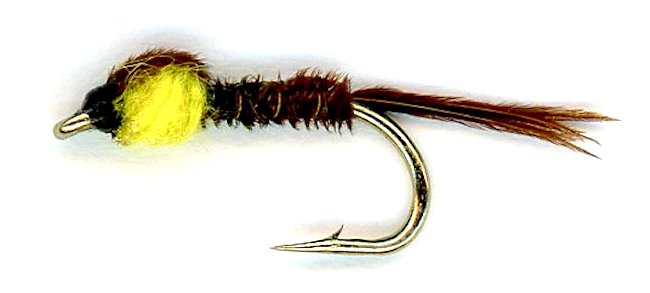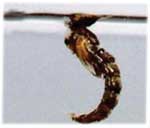The Yellow Pheasant Tail Nymph Fly
Yellow Pheasant Tail Nymph is great for trout and grayling flyfishing in lakes, lochs and rivers. It can be used as a point fly or put on a dropper

PHEASANT TAIL FLY PATTERNS. Hook size 12 14 16 18 - $US each
How to fish the Yellow Pheasant Tail Nymph
How to fish the Yellow Pheasant Tail NymphThe Yellow Pheasant Tail nymph is designed to imitate the type of food that makes up the majority of a Trout’s daily intake. They love feeding on mayfly nymphs that have been dislodged from the river bottom and are drifting in the current or those that are rising to the surface to hatch into adult Mayfly duns. While it is relatively easy to spot trout feeding on duns and spinners floating in the river surface, it is not so easy to observe them feeding down below. So how do you work out where to fish for trout feeding on nymphs? Many of the place that trout are seen to be feeding on the top are also the same places that they will be feeding on rising nymphs. These can be at the head or tailout of a pool, behind a rock, along a feed line crease or just off a shelf. Trout are often been called lazy as they find a calmer location where they do not have to constantly fight the current and their food comes to them. They are not lazy. I call that clever. Why waste a lot of calories chasing your food if the energy you expend in catching it does not equal the amount of calories you will get back from eating it once caught.
During an emergence of caddis, stoneflies, midges or mayflies predatory trout will station themselves where they can intercept the emerging insects and still stay in calmer water. Take time to study the structure of the river. Look for creases; areas where faster water meets slower water. Spot obstructions like boulders or fallen tree trunks that provide shelter for the waiting trout. Fish will hold just off the shelf at the lower end of a riffle, in the slower water along the bottom and grab dislodged invertebrates that drift past them

Once you have mastered the skill of spotting good nymph fishing locations you must next master the ability to recognise when to set the hook. It is easy to notice a vigorous take but the majority of your subsurface nibbles will be subtle. The general rule of thumb is that if it looks suspicious then set the hook. Look for your strike indicator to just tip down a little, skate a couple of inches across the surface, pause, speed up or slow down. If that observed action is contrary to the movement of the water then set the hook. It is a skill that comes with practice so get out on the water as often as you can.
I was fishing with a group of friends on the Yellowstone river. It is full of small aquatic invertebrates that require hook sizes of 16, 18 and 20 to imitate them correctly. The big trout were taking everything they could see. The takes were subtle and often slow and gentle. I was out catching my friends who could not work out what was a take and what wasn’t. They were seeing the indicator dip down very slowly and wrongly concluded that it was caused by the bottom. They were expecting more dramatic takes. I had to educate them that this was a hook setting signal. If it was the bottom you would come up empty or with some river bed debris. If it was a rainbow or brookie you would be having fun trying to play it into your net.
I always let my nymphs rise at the end of every drift. This is especially effective during an emergence as the fish will target nymphs or caddis pupae rising up from the bottom. You must be prepared to deal with any take. Time and time again I see other fly fishermen fail to catch a trout at the end of a drift as they lose concentration and are mentally preparing to make another cast. As soon as the nymphs on you fishing rig start to swing up, the chances are good that any nearby trout will nail your artificial fly.


Fly Fishing books

